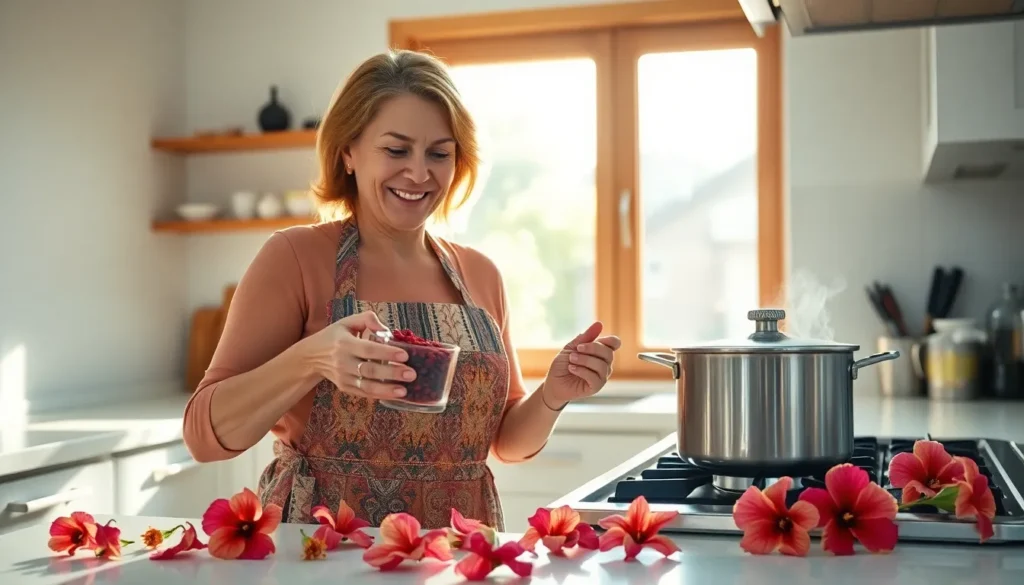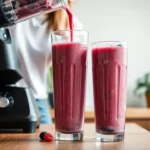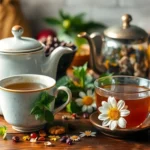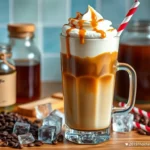Vibrant ruby-red hibiscus tea transforms your ordinary tea time into an extraordinary experience. This naturally caffeine-free herbal beverage delivers a tart cranberry-like flavor that’s both refreshing and packed with antioxidants. We’ve discovered that hibiscus tea isn’t just beautiful to look at – it’s incredibly versatile and surprisingly simple to make at home.
Originally enjoyed across Africa and the Caribbean, hibiscus tea has gained popularity worldwide for its stunning color and potential health benefits. Whether you’re looking to reduce your caffeine intake or simply want to try something new, this floral infusion offers the perfect balance of tartness and subtle sweetness.
We’ll show you how to brew the perfect cup using dried hibiscus petals, along with our favorite variations that include honey, ginger, and citrus. You’ll be amazed at how this simple ingredient can create such a complex and satisfying drink that’s equally delicious served hot or iced.
Ingredients
We’ve carefully selected ingredients that highlight hibiscus tea’s natural tartness while offering flexibility for customization. These simple pantry staples create both traditional and enhanced versions of this beloved herbal brew.
For Basic Hibiscus Tea
- 2 tablespoons dried hibiscus petals (or 4 hibiscus tea bags)
- 4 cups filtered water
- Sweetener of choice (honey, sugar, or agave) to taste
For Flavored Variations
Honey Ginger Hibiscus Tea:
- 2 tablespoons dried hibiscus petals
- 4 cups filtered water
- 1 inch fresh ginger root, thinly sliced
- 2-3 tablespoons raw honey
- 1 cinnamon stick (optional)
Citrus Hibiscus Iced Tea:
- 2 tablespoons dried hibiscus petals
- 4 cups filtered water
- Juice of 1 fresh lemon
- Juice of 1 fresh lime
- 2 tablespoons sugar or honey
- Fresh mint leaves for garnish
- Ice cubes for serving
- 2 tablespoons dried hibiscus petals
- 4 cups filtered water
- 3-4 whole cardamom pods
- 1 cinnamon stick
- 2-3 whole cloves
- 1 tablespoon honey or maple syrup
Equipment Needed
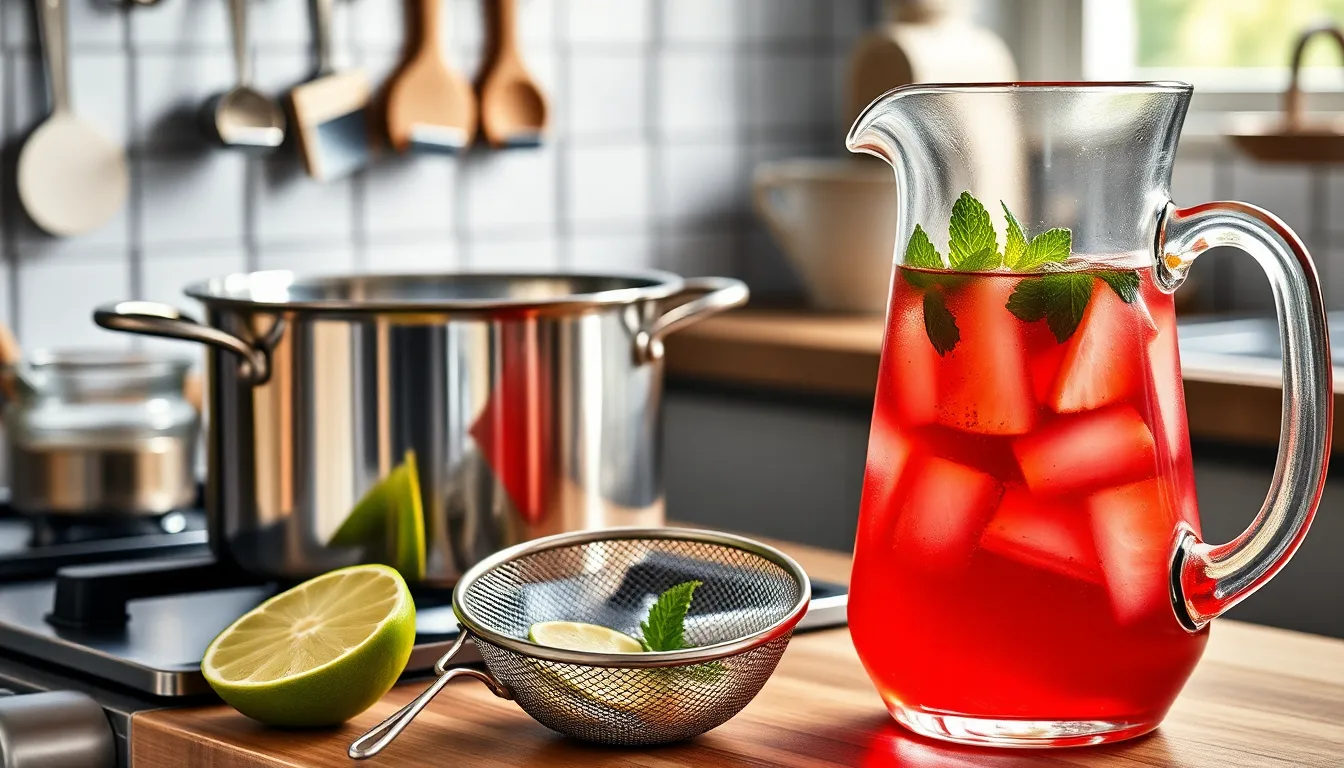
Making delicious hibiscus tea requires just a few basic kitchen tools that you likely already have at home. We’ve found that having the right equipment makes the brewing process smoother and ensures the best flavor extraction from your hibiscus petals.
Essential Equipment:
- Large pot or kettle – For boiling or simmering the 8 cups of water needed for our recipe
- Fine mesh strainer or tea infuser – Critical for removing hibiscus flowers and any additional herbs from the finished tea
- Measuring cups and spoons – For accurate measurements of ingredients like the 1/2 cup dried hibiscus flowers and sweeteners
- Spoon for stirring – To properly dissolve honey or sugar and mix in lime juice
- Glass pitcher – Perfect for chilling and serving iced hibiscus tea
Optional but Helpful Equipment:
- Lime squeezer – Makes extracting the 3 tablespoons of fresh lime juice much easier
- Sharp knife – For slicing lime wedges or preparing fresh garnishes like mint sprigs
The beauty of hibiscus tea lies in its simplicity. Most home cooks already own these basic tools, making this antioxidant-rich beverage accessible to brew anytime. Our equipment list focuses on functionality rather than specialty items, ensuring you can create this refreshing drink without investing in expensive tea accessories.
Instructions
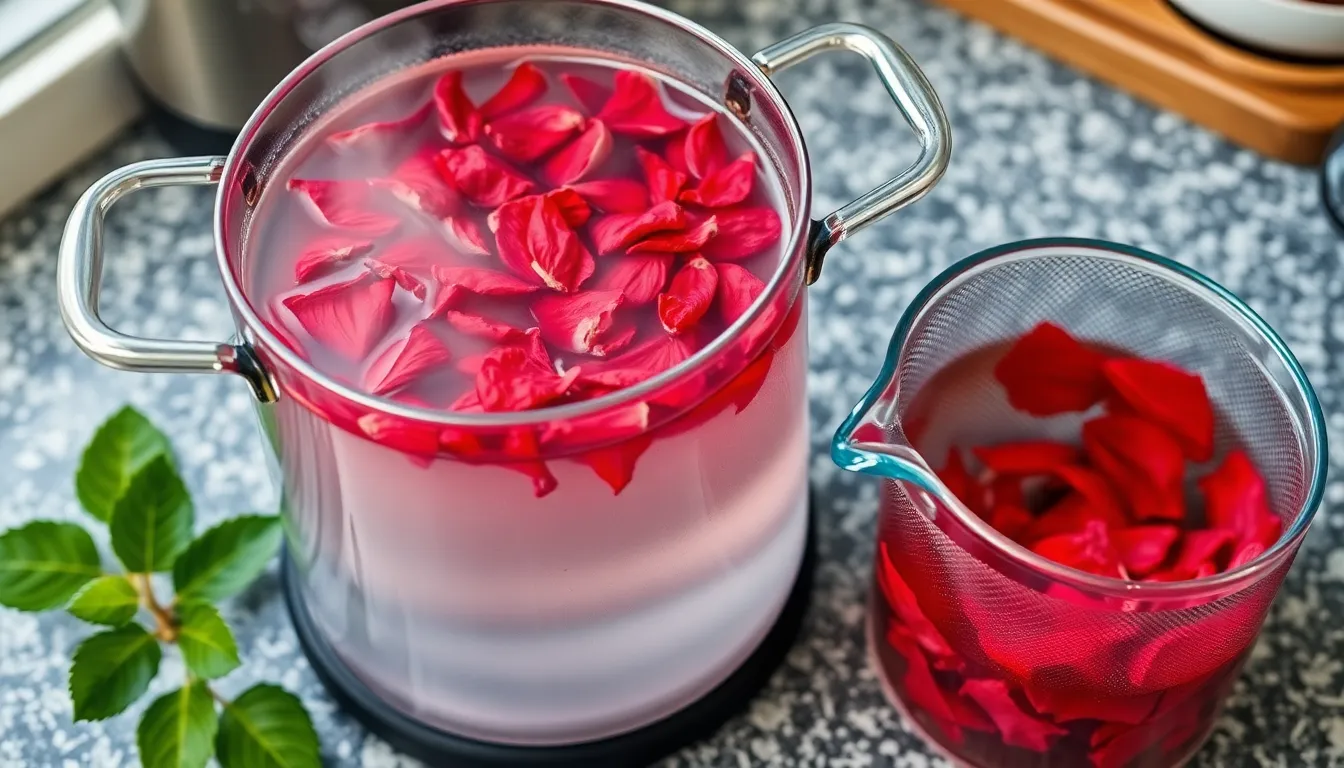
Creating hibiscus tea requires just a few simple steps that deliver maximum flavor. We’ll guide you through each stage to ensure perfect results every time.
Prep the Hibiscus Flowers
Fresh hibiscus flowers need proper preparation before brewing. We remove the calyx (green base) from each flower and optionally take out the pistil for a cleaner taste. Dried hibiscus flowers require no preparation and can go directly into the brewing pot. Measure out 2 cups of fresh flowers or 1/2 cup of dried hibiscus petals for our 8-cup batch.
Boil the Water
Start by bringing 8 cups of water to a rolling boil in a large pot. We use filtered water when possible to ensure the purest flavor profile. The pot should be large enough to accommodate both the water and hibiscus flowers with room for stirring. Once bubbles form rapidly across the surface, our water has reached the perfect temperature for steeping.
Steep the Tea
Add the hibiscus flowers to the boiling water and immediately turn off the heat. Cover the pot to trap the steam and essential oils that create hibiscus tea’s signature flavor. We let the mixture steep for 15-20 minutes to achieve a robust, deeply colored tea with full-bodied taste. For those preferring a milder flavor, 5 minutes of steeping time produces a lighter brew.
| Steeping Time | Flavor Profile |
|---|---|
| 5 minutes | Light, delicate flavor |
| 15-20 minutes | Strong, full-bodied taste |
Strain and Serve
Pour the steeped tea through a fine mesh sieve into a pitcher, removing all flower particles for a smooth drinking experience. We discard the used hibiscus flowers after straining. Add 1/4 cup of honey and 3 tablespoons of fresh lime juice to taste, adjusting these amounts based on personal preference. Serve the tea warm immediately or chill it in the refrigerator for a refreshing cold beverage.
Directions for Hot Hibiscus Tea
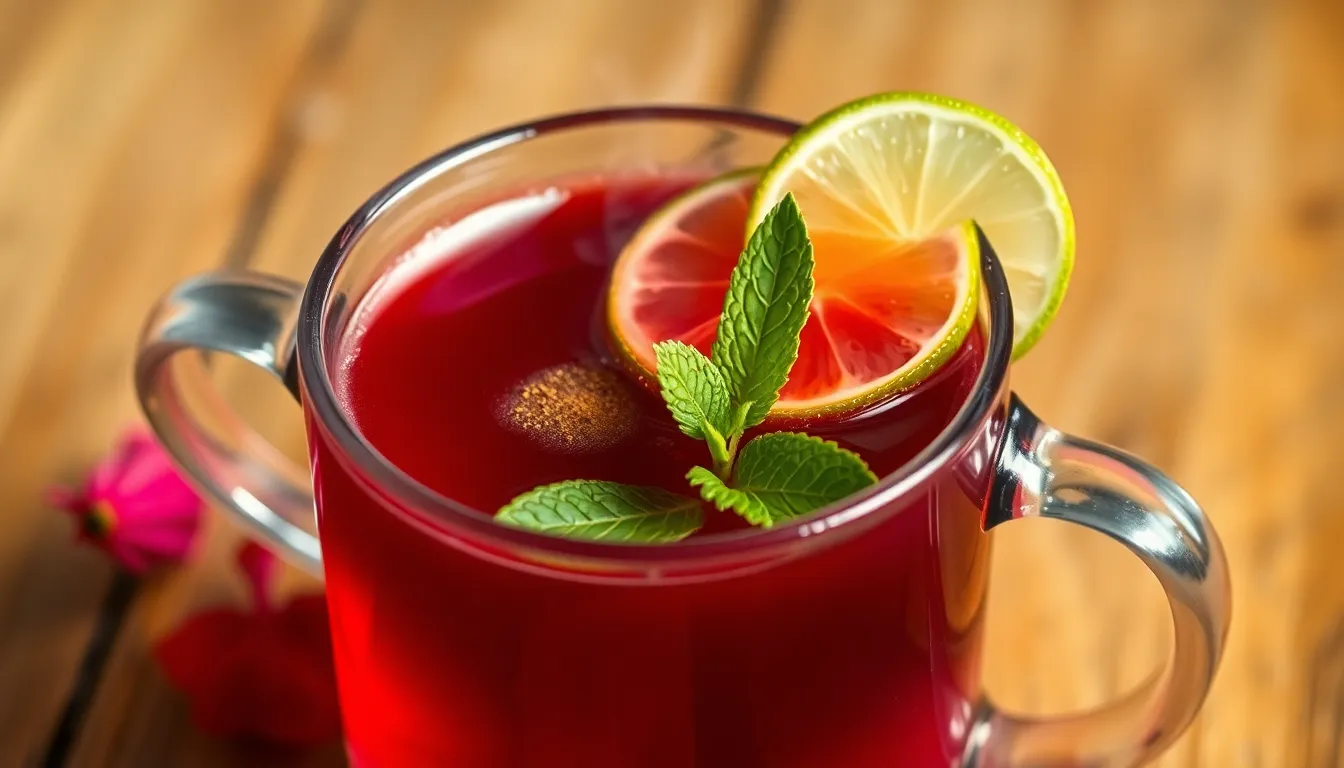
Now we’ll walk through the precise steps to create the perfect hot hibiscus tea that delivers vibrant flavor and maximum antioxidant benefits.
Step 1: Prepare Your Hibiscus Flowers
We begin by examining our hibiscus flowers for optimal brewing. Fresh hibiscus flowers require removing the green calyx at the base and optionally the thin central pistil tube. Dried hibiscus flowers need no preparation and can go directly into our brewing vessel.
Step 2: Boil the Water
Bring 8 cups of filtered water to a rolling boil in our large pot or kettle. For single servings we pour 1 cup of boiling water directly over 1 tablespoon of dried hibiscus flowers placed in our mesh infuser. The water temperature should reach 212°F for optimal extraction of the flowers’ beneficial compounds.
Step 3: Steep for Perfect Strength
We allow the hibiscus flowers to steep for 15 to 20 minutes when seeking a robust and deeply colored tea. Those preferring a lighter flavor can reduce steeping time to just 5 minutes. Covering our pot during steeping helps retain heat and prevents essential oils from escaping. Extended steeping beyond 20 minutes can introduce unwanted bitterness to our final brew.
Step 4: Add Sweeteners While Hot
Sweeteners dissolve most effectively in hot liquid so we stir in honey, sugar, or jaggery immediately after steeping. Start with 2 to 3 tablespoons of sweetener for 8 cups of tea and adjust according to taste preferences. Fresh lime juice adds bright acidity that complements the tea’s natural tartness.
Step 5: Strain Thoroughly
We pour our steeped tea through a fine mesh strainer to remove all flower particles and create a smooth drinking experience. Double straining ensures no sediment remains in our finished tea.
Step 6: Serve Immediately
Hot hibiscus tea reaches its peak flavor when served fresh from brewing. We can garnish each cup with lime slices or fresh mint leaves for enhanced visual appeal and aromatic complexity. The tea maintains its temperature for approximately 30 minutes when kept covered.
Directions for Iced Hibiscus Tea
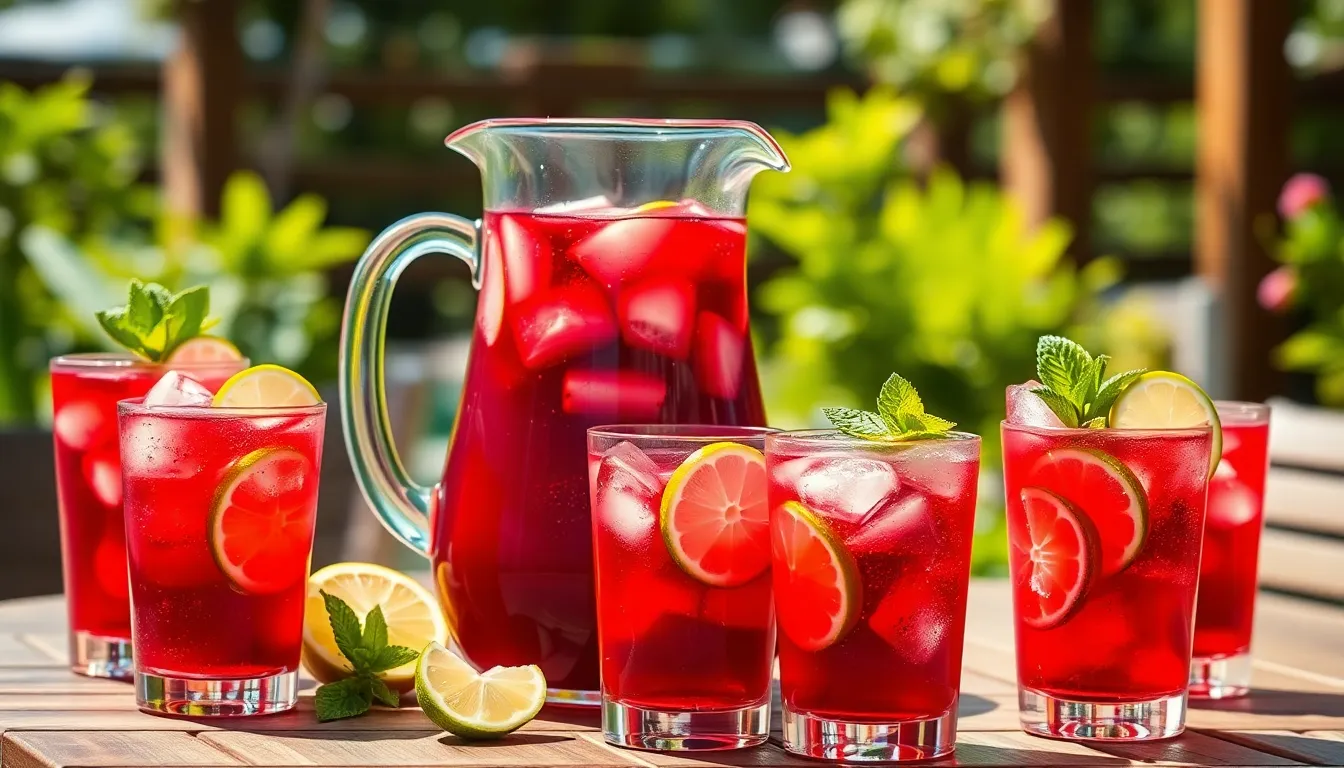
We begin by bringing 6 cups of water to a rolling boil in a large saucepan. This substantial amount creates the concentrated base that delivers the deep ruby color hibiscus tea is famous for.
Step 1: Add Hibiscus and Spices
Once the water reaches a full boil, we stir in 2 cups of dried hibiscus petals along with our optional spices. The cinnamon stick adds warmth while the pinch each of ground cloves, nutmeg, and allspice creates complexity. We reduce the heat to medium-low and allow the mixture to gently simmer until the liquid transforms into a rich, deep red color—typically 30 to 45 minutes.
Step 2: Sweeten the Concentrate
We stir in ½ cup of chopped piloncillo or 1½ cups of white sugar while the tea remains hot. The sugar dissolves completely in the warm liquid, ensuring even sweetness throughout. After sweetening, we remove the saucepan from heat and let it cool for 15 minutes.
Step 3: Strain Thoroughly
Using a fine mesh strainer, we pour the warm hibiscus liquid into a pitcher. We press the hibiscus petals firmly against the strainer to extract every drop of flavorful liquid before discarding the solids.
Step 4: Dilute and Chill
We add enough cold water to fill a 1-gallon pitcher, effectively diluting our concentrated hibiscus base to drinking strength. The tea needs several hours in the refrigerator to become properly chilled.
Step 5: Serve Over Ice
We pour the chilled hibiscus tea over ice-filled glasses for immediate refreshment. Lime wedges or fresh mint sprigs make excellent garnishes that complement the tart flavor profile.
For those preferring a quicker method, we can steep 1 tablespoon of dried hibiscus flowers in 1 cup of boiling water for just 5 minutes, then chill and serve over ice with honey or sugar adjusted to taste.
Flavor Variations
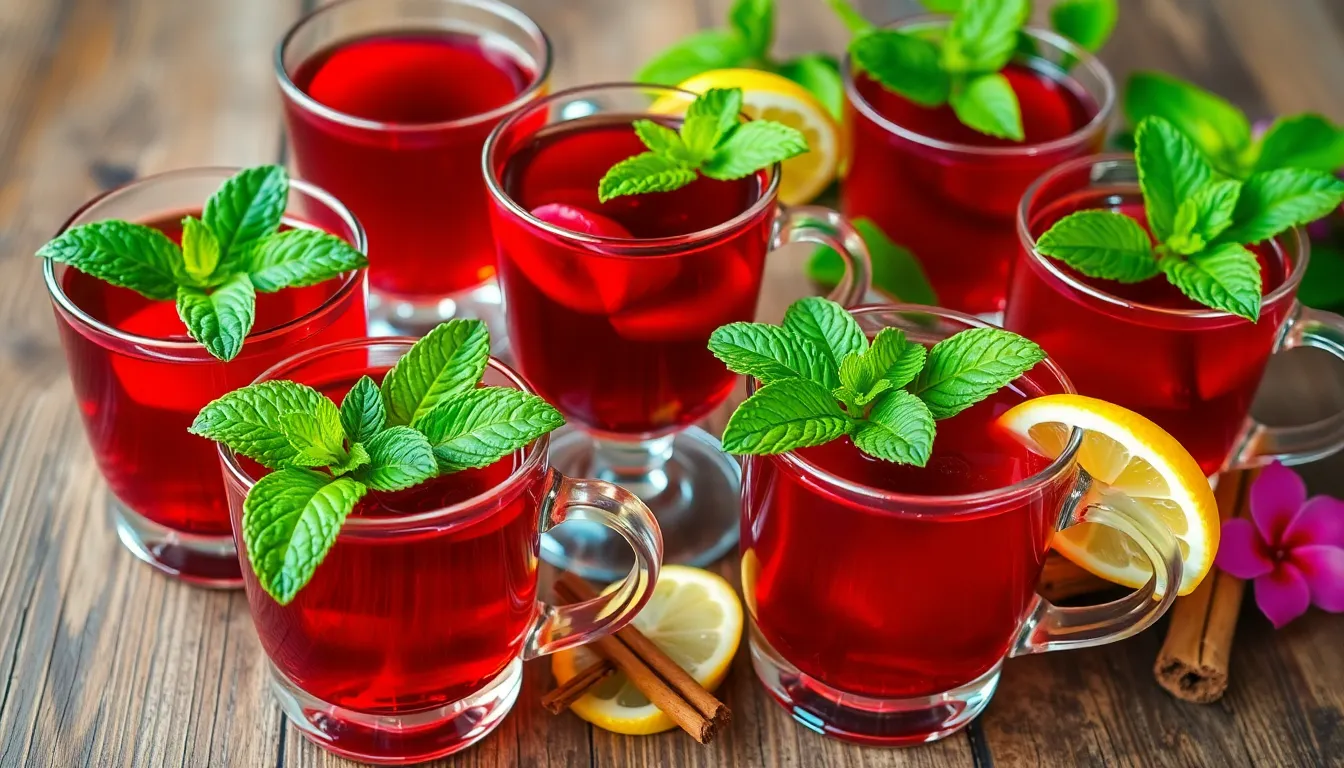
We can transform our basic hibiscus tea into exciting flavor combinations that enhance its natural tartness. These variations allow us to customize our brew according to personal taste preferences and seasonal moods.
Hibiscus Ginger Tea
We add fresh grated ginger to create a warming and spicy twist on our classic hibiscus tea. For each cup of tea we combine 2 teaspoons of dried hibiscus petals with 1 teaspoon of freshly grated ginger before steeping in boiling water. The ginger complements the natural tartness of hibiscus while providing a pleasant heat that warms us from within. We steep this combination for 5 to 10 minutes depending on our desired strength. Honey works particularly well as a sweetener for this variation as it balances both the tart hibiscus and spicy ginger notes. We can serve this tea hot during colder months or pour it over ice for a refreshing summer drink.
Hibiscus Mint Tea
We combine dried hibiscus petals with fresh mint leaves to create a refreshing and aromatic blend. For every 4 cups of water we use our standard amount of hibiscus petals along with 1 small bunch of fresh mint leaves. The mint adds a cooling effect that perfectly balances the tartness of the hibiscus flowers. We steep both ingredients together for the same duration as our basic recipe then strain carefully to remove all plant matter. Fresh lemon slices make an excellent garnish for this variation when served over ice. This combination works exceptionally well as an iced tea during hot weather as the mint provides natural cooling properties.
Hibiscus Lemon Tea
We enhance our hibiscus tea with bright citrus flavors by adding fresh lemon juice after steeping. First we prepare our hibiscus tea using the standard method then add fresh lemon juice to taste once we’ve strained the flowers. Lemon wedges serve as both garnish and additional flavor enhancement when we serve this variation. The citrus brightens the deep red color of our hibiscus tea while adding vitamin C and complementing the natural tartness. We can adjust the lemon quantity based on our preference for citrus intensity. A touch of honey helps balance the combined tartness of both hibiscus and lemon when desired.
Hibiscus Cinnamon Spice Tea
We create a warming spiced version by adding cinnamon to our hibiscus petals before steeping. One cinnamon stick per 4 cups of water provides the perfect amount of spice without overwhelming the hibiscus flavor. Ground cinnamon works as an alternative though we use it sparingly to avoid a gritty texture in our finished tea. The cinnamon adds warmth and complexity that makes this variation perfect for cooler weather. We can sweeten this spiced tea with honey maple syrup or agave depending on our preference. This variation tastes equally delicious served hot or chilled and the cinnamon aroma adds an inviting sensory element to our tea experience.
Make-Ahead Instructions
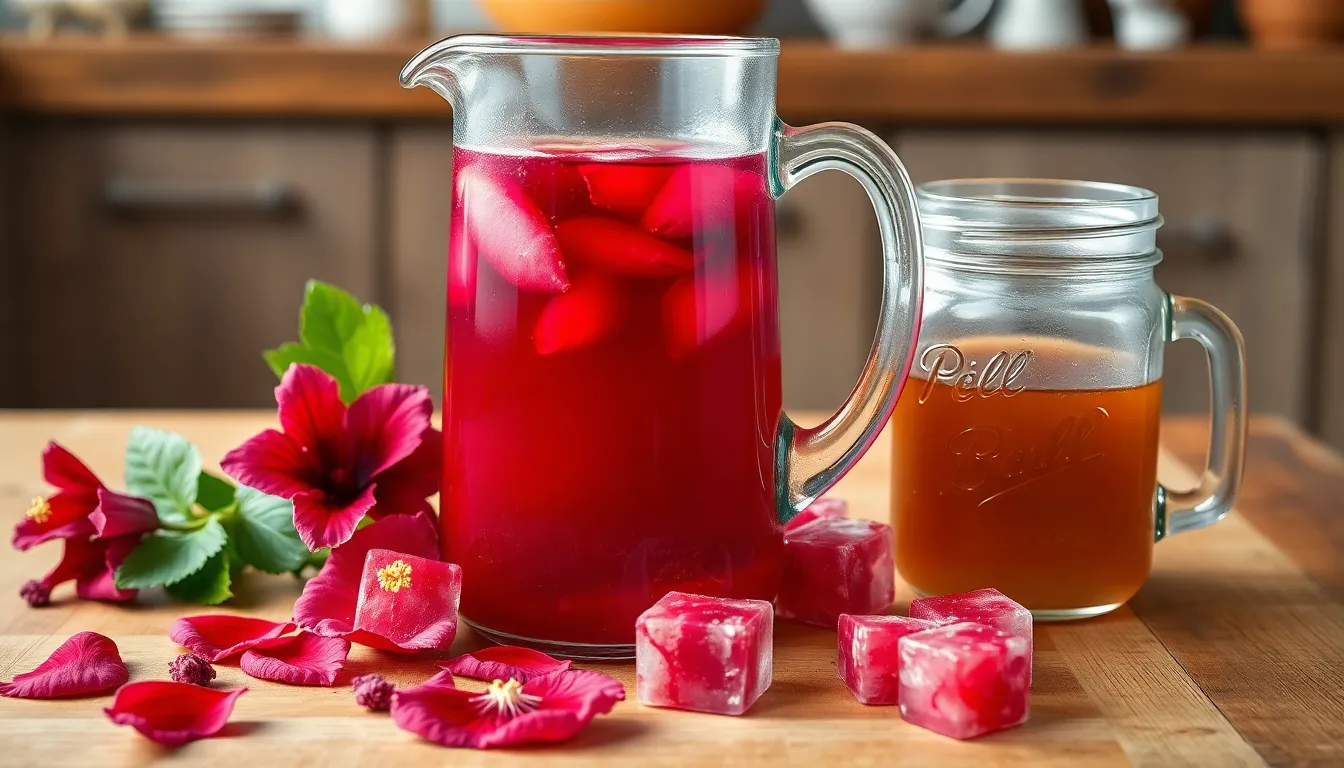
We love preparing hibiscus tea ahead of time to enjoy throughout the week. The concentrated brewing method works particularly well for advance preparation since we can store the concentrate and dilute it as needed.
For hot hibiscus tea preparation, we recommend brewing a double-strength concentrate by using 4 tablespoons of dried hibiscus petals per 4 cups of water. Steep the mixture for 20 minutes to extract maximum flavor and color. After straining, we store this concentrate in the refrigerator for up to 5 days in an airtight container.
Cold brewing offers excellent make-ahead potential for our hibiscus tea routine. We combine 1 cup of dried hibiscus petals with 8 cups of room temperature water in a large pitcher. The mixture needs to steep in the refrigerator for at least 4 hours, though we often let it brew for up to 2 days for deeper flavor development. This method produces a smoother, less acidic tea that many find more refreshing.
Storage containers play a crucial role in maintaining freshness. We use glass pitchers or mason jars to prevent any flavor transfer that might occur with plastic containers. The natural acids in hibiscus tea can react with certain plastics over time.
Sweetening ahead requires special consideration since granulated sugar dissolves poorly in cold liquids. We prepare simple syrup by combining equal parts sugar and hot water, then cooling completely before adding to our chilled hibiscus tea. Alternatively, we add honey or maple syrup to the hot concentrate before refrigeration.
Batch preparation saves important time during busy weeks. We often prepare multiple flavor variations simultaneously, using different spice combinations in separate containers. This approach allows us to enjoy variety without daily preparation time.
| Storage Method | Duration | Best For |
|---|---|---|
| Refrigerated concentrate | 5 days | Hot tea preparation |
| Cold brew | 7 days | Iced tea service |
| Frozen concentrate | 3 months | Long-term storage |
The concentrated hibiscus tea freezes exceptionally well in ice cube trays. We pour the strained concentrate into trays and freeze until solid. These hibiscus cubes can be stored in freezer bags for up to 3 months and added directly to hot water for instant tea preparation.
Storage Tips
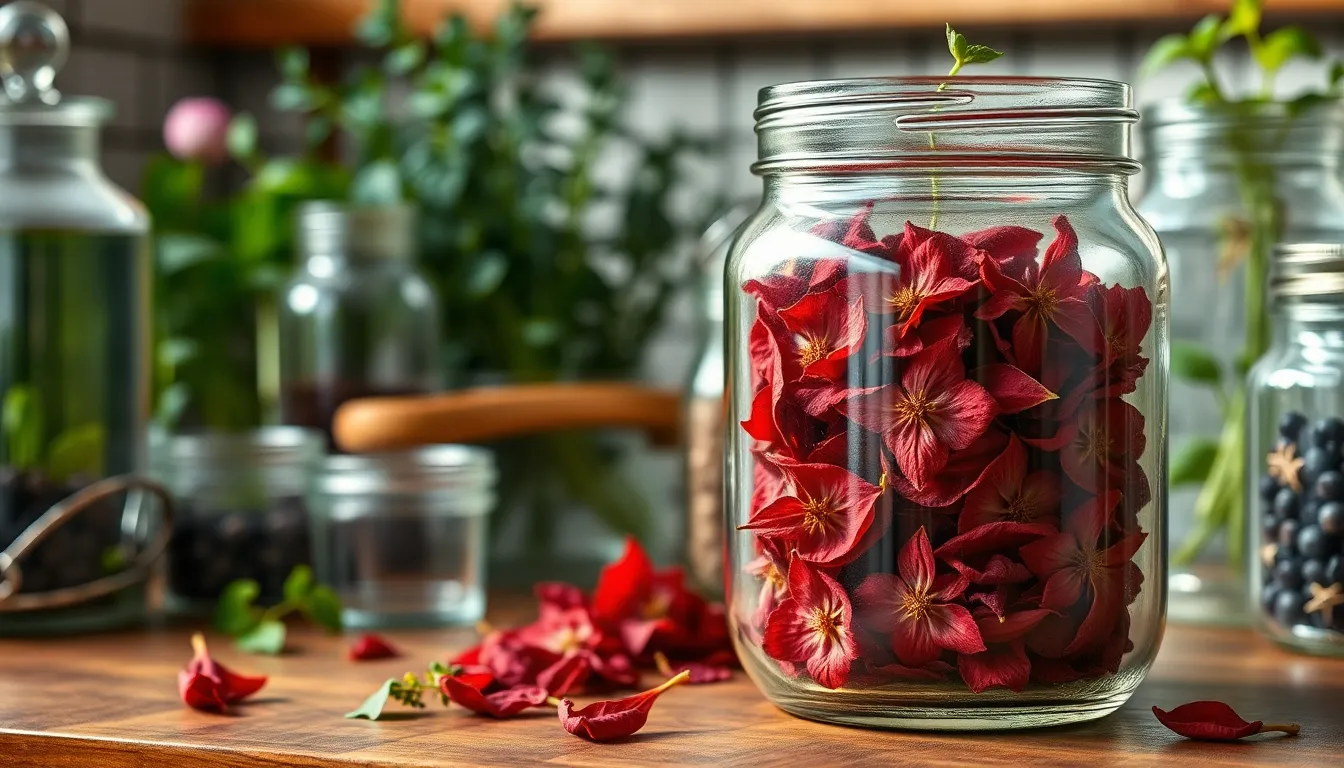
Proper storage techniques will help us maintain the vibrant flavor and quality of both our dried hibiscus petals and brewed tea. We need to protect these delicate botanicals from elements that can degrade their taste and beneficial compounds.
Dried Hibiscus Petals Storage
Our dried hibiscus petals perform best when stored in airtight containers that shield them from oxygen and moisture. Glass jars with tight-fitting lids or vacuum-sealed bags provide excellent protection against air exposure that can diminish the tea’s crisp flavor profile.
We should place these containers in cool dry locations away from direct sunlight and heat sources like stovetops or radiators. Temperature fluctuations can cause condensation inside containers leading to mold growth and flavor deterioration.
Strong-smelling items such as spices coffee beans or cleaning products need to stay separate from our hibiscus storage area. These powerful aromas can transfer to the delicate petals and alter the tea’s natural tart cranberry-like taste.
Brewed Tea Storage
Fresh hibiscus tea requires refrigeration in clean sealed glass bottles to maintain optimal flavor and prevent bacterial growth. We recommend consuming our brewed tea within a few days for the best taste experience.
| Storage Method | Duration | Container Type |
|---|---|---|
| Refrigerated brewed tea | 3-5 days | Glass bottles with tight lids |
| Dried hibiscus petals | 12-18 months | Airtight containers |
| Frozen tea concentrate | 3-6 months | Ice cube trays or freezer bags |
Glass containers work better than plastic alternatives because they do not absorb flavors or release chemicals that might affect our tea’s pure taste. We can also freeze concentrated hibiscus tea in ice cube trays for extended storage up to six months.
Room temperature storage of brewed hibiscus tea is not recommended as the liquid can spoil quickly without refrigeration. Always transfer our freshly brewed tea to the refrigerator within two hours of preparation to ensure food safety standards.
Serving Suggestions
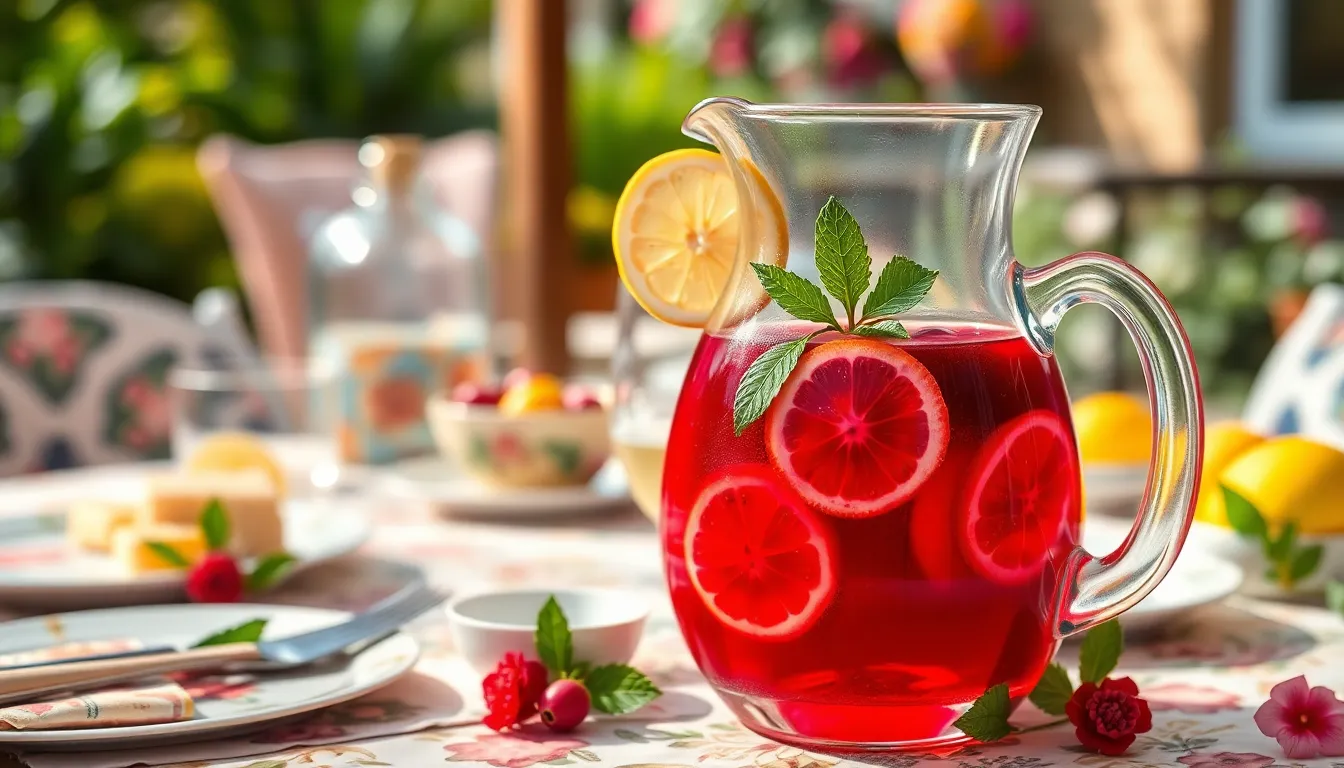
Our hibiscus tea’s vibrant ruby red color makes it a stunning centerpiece for any gathering. We love serving this eye-catching beverage in clear glass pitchers to showcase its beautiful hue at weddings and holiday parties. Fresh fruit garnishes like lemon wheels, lime slices, or sprigs of mint transform the drink into an elegant presentation that guests will remember.
Afternoon tea service becomes extraordinary when we pair hibiscus tea with delicate pastries, buttery scones, and classic finger sandwiches. The tea’s natural tartness provides a refreshing contrast to sweet treats while cleansing the palate between bites. We recommend serving it slightly chilled during warmer months or piping hot when the weather calls for comfort.
Brunch tables benefit tremendously from our hibiscus tea’s bright, tangy profile. We find it complements light dishes like fresh fruit salads, creamy avocado toast, and herb-filled quiches beautifully. The tea’s natural acidity balances rich breakfast foods while its caffeine-free nature makes it perfect for leisurely weekend meals.
Outdoor barbecues and grilled gatherings showcase hibiscus tea at its finest. We serve it ice-cold as a thirst-quenching companion to smoky meats and spicy foods. The tea’s cooling properties provide welcome relief from bold flavors while its tangy notes enhance the overall dining experience.
Large batch preparation works wonderfully for entertaining. We brew concentrated hibiscus tea using ¾ cup of dried flowers in 4 to 6 cups of water, then dilute with cold water and ice just before serving. This method ensures consistent flavor while allowing us to accommodate varying taste preferences with different sweetener options on the side.
Special occasions call for creative presentation ideas. We freeze hibiscus tea in ice cube trays with fresh berries or mint leaves for decorative ice that won’t dilute the drink. Serving the tea in mason jars with colorful paper straws adds a casual, festive touch that appeals to all ages.
Health Benefits of Hibiscus Tea
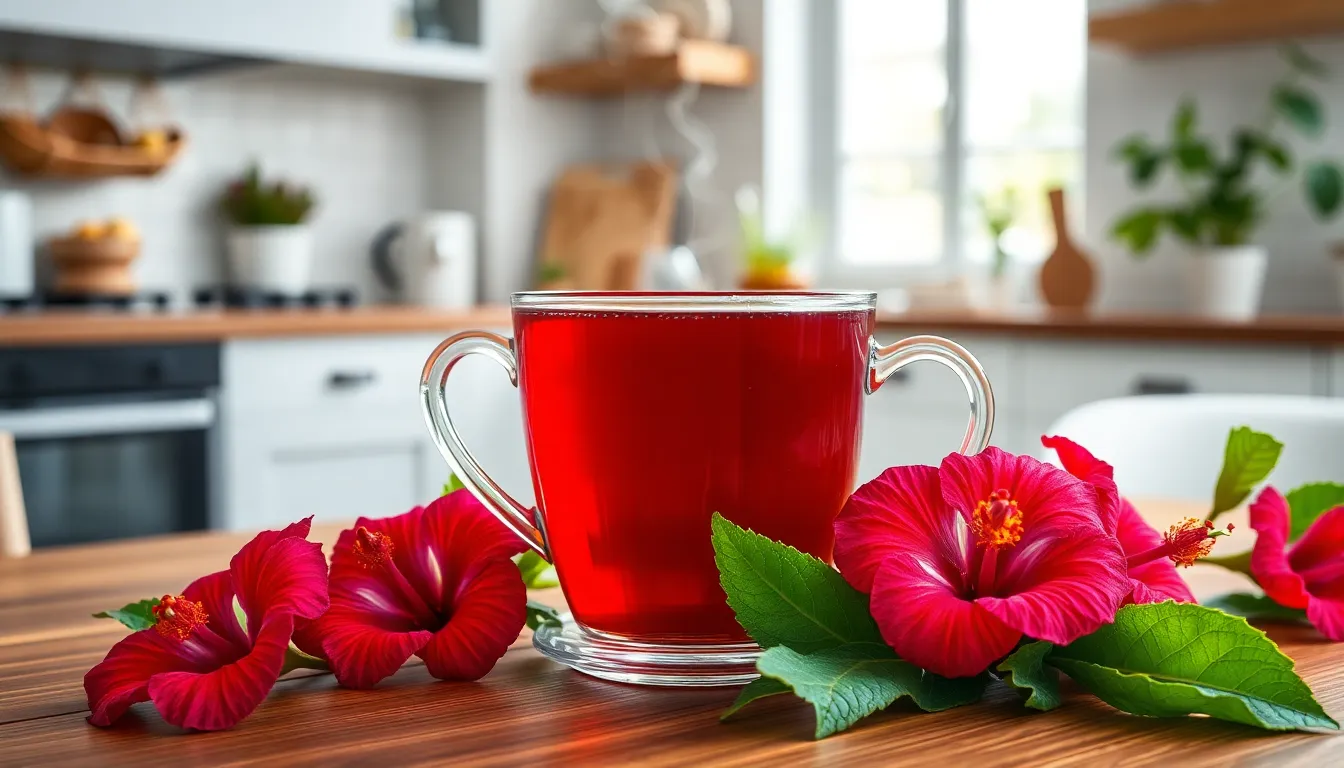
Beyond its vibrant color and refreshing taste, hibiscus tea offers impressive health benefits that make it more than just a delicious beverage. Research has identified several key advantages that support our overall wellness when we incorporate this ruby red tea into our daily routine.
Blood Pressure Support
Studies demonstrate that hibiscus tea may help lower blood pressure, making it particularly beneficial for managing hypertension. We can enjoy this natural approach to cardiovascular health by drinking hibiscus tea regularly as part of a balanced lifestyle.
Antibacterial Properties
The natural compounds in hibiscus flowers possess antibacterial properties that could help reduce harmful bacterial growth in our bodies. These antimicrobial benefits add another layer of wellness support to our daily tea ritual.
Weight Management Support
Hibiscus tea can aid in weight loss efforts by promoting metabolism and acting as a natural diuretic. We benefit from these properties without adding calories to our diet, especially when enjoying the tea unsweetened or with minimal natural sweeteners.
| Health Benefits | Key Effects |
|---|---|
| Blood Pressure | May help lower hypertension levels |
| Antibacterial | Reduces harmful bacterial growth |
| Weight Support | Promotes metabolism and acts as natural diuretic |
| Antioxidants | Provides cellular protection |
The antioxidant properties we discussed earlier work synergistically with these exact health benefits to create a comprehensive wellness beverage. Each cup we brew delivers not only the tart, cranberry like flavor we love but also these researched health promoting compounds that support our cardiovascular system and overall vitality.
Conclusion
We’ve shown you how simple it is to brew this vibrant ruby-red tea that’s both delicious and beneficial for your health. Whether you prefer it hot on a chilly morning or iced for summer refreshment the brewing process remains straightforward with endless customization possibilities.
The beauty of hibiscus tea lies in its versatility – from basic recipes to creative flavor combinations with ginger mint or citrus. With proper storage techniques and make-ahead methods you can always have this antioxidant-rich beverage ready to enjoy.
Start experimenting with our recipes and discover your favorite hibiscus tea variation. Your taste buds and your health will thank you for adding this naturally caffeine-free powerhouse to your daily routine.
Frequently Asked Questions
What is hibiscus tea?
Hibiscus tea is a naturally caffeine-free herbal beverage made from dried hibiscus petals. It has a vibrant ruby red color and offers a tart, cranberry-like flavor. Originally from Africa and the Caribbean, this antioxidant-rich tea has gained global popularity as a refreshing alternative to caffeinated beverages.
How do you make basic hibiscus tea?
To make basic hibiscus tea, use 2 tablespoons of dried hibiscus petals or 4 tea bags with 4 cups of filtered water. Boil the water, add hibiscus, and steep for 15-20 minutes for robust flavor or 5 minutes for lighter taste. Strain and add sweetener to taste.
What equipment do I need to brew hibiscus tea?
You need basic kitchen equipment that most home cooks already own: a large pot or kettle for boiling water, a fine mesh strainer or tea infuser for removing hibiscus flowers, and measuring cups and spoons for accurate ingredient measurements. No expensive tea accessories are required.
How long should I steep hibiscus tea?
Steep hibiscus tea for 15-20 minutes for a robust, full-flavored brew, or 5 minutes for a lighter taste. The longer steeping time allows the hibiscus petals to release more flavor and antioxidants, creating the characteristic tart taste and vibrant red color.
Can I make iced hibiscus tea?
Yes! For iced hibiscus tea, boil 6 cups of water and add 2 cups of dried hibiscus petals. Simmer for 30-45 minutes, sweeten while hot, then strain into a pitcher. Dilute with cold water, chill in the refrigerator, and serve over ice with lime wedges or mint.
What are popular hibiscus tea flavor variations?
Popular variations include Hibiscus Ginger Tea (with fresh grated ginger), Hibiscus Mint Tea (with fresh mint leaves), Hibiscus Lemon Tea (with fresh lemon juice), and Hibiscus Cinnamon Spice Tea (with cinnamon). Each variation complements the natural tartness while adding unique flavor profiles.
How should I store hibiscus tea and dried petals?
Store dried hibiscus petals in airtight containers in cool, dry locations away from sunlight and strong odors. Brewed hibiscus tea should be refrigerated in clean, sealed glass bottles and consumed within a few days to maintain freshness and prevent spoilage.
What are the health benefits of hibiscus tea?
Hibiscus tea may help lower blood pressure, provide antibacterial properties, and support weight management. Rich in antioxidants, it supports cardiovascular health and overall vitality. The antioxidant properties work synergistically with these health benefits, making it a comprehensive wellness beverage for daily consumption.
Can I make hibiscus tea ahead of time?
Yes! You can make a concentrated hibiscus tea by brewing double-strength concentrate for easy storage throughout the week. Store in glass containers in the refrigerator, or freeze hibiscus tea in ice cube trays for long-term use. This batch preparation approach offers convenience and variety.
What foods pair well with hibiscus tea?
Hibiscus tea pairs excellently with pastries for afternoon tea, light brunch dishes, and smoky meats at barbecues. Its vibrant ruby red color makes it an attractive centerpiece for gatherings. Consider preparing large batches for entertaining and using creative presentations with fruit-filled ice cubes.

